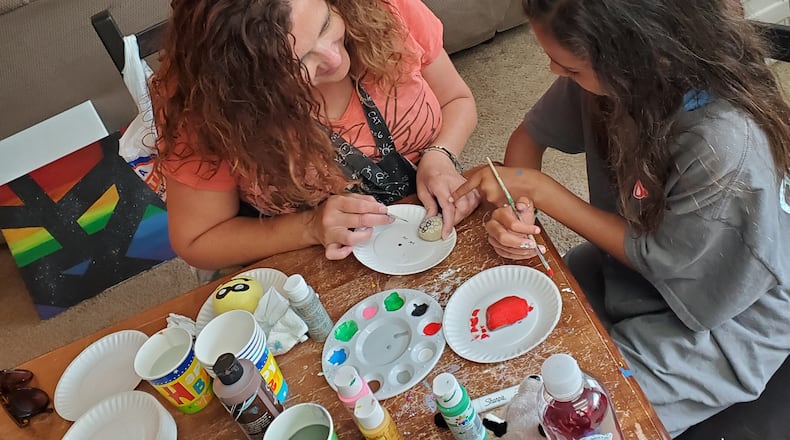When the stay-at-home orders began, Craighead and her husband decided to create a pod with one other neighborhood family. The two families have dinner together at least a couple of times a week. “I feel this was one of the best decisions we could have made for my 9-year-old and our own sanity,” she says now. “I am not sure how we would have coped without having another family to be with. Humans are generally social animals that need others.”
The new school year has presented more challenging decisions, often with no clear “right or wrong” answers.
Centerville psychotherapist Amanda Matthias says we are living in unprecedented times. “I know many families are dealing with a difficult decision right now when it comes to whether or not to send kids back to school this fall,” she says. “It is all about the planning and thought we engage in prior to making a decision that makes a difference in our ability to accept and live with the consequences once the decision has been made. We cannot prevent the storm from coming, but we can prepare for it.”
Credit: CONTRIBUTED
Credit: CONTRIBUTED
A parent’s perspective
Craighead describes the virtual learning that began in March as a nightmare. A teacher by trade, she still found teaching her daughter one of the most difficult things she’s ever had to do.
“Evie was a third-grader who loved school and reading,” Craighead says. “Within a couple of short weeks, she hated school and started to despise reading. My 17-year-old, who hated school to begin with, disliked it even more and asked when he could go back to in-person learning. It was rough and something I had hoped would miraculously go away by the beginning of the school year.”
In recent weeks, Craighead has faced more decisions. “I pondered our choices daily as the deadline to choose ticked closer and closer,” she recalls. “Both of our children wanted to return to school.”
She says the more she read, the more she knew she didn’t want her children to be guinea pigs while the schools did the best they could to meet state guidelines, keep the children safe, and teach them.
“Does being in a classroom full of kids with masks, where facial expressions are difficult to read and trying to remain socially distant make sense?” she wondered. “Is that socially and emotionally safe? Does it set the children up for being successful at school? "
A supporter of the public school system, she considered enrolling her children in virtual learning through the school district, but realized virtual learning had been a real challenge for them. “I also worried if I enrolled my children in an established virtual school it would pull money from the public school,” she says. “And where would I even start in weeding through the numerous options?”
Another option was to home school her kids while working full time or join a local “pod” where another parent would teach her children in a small group.
Craighead says these decisions for herself and other parents were impossible. She decided to keep her daughter at home for virtual learning and to let her 17-year-old son, Bobby, make his own decision. Enrolled in a career tech school, he requires hands-on smaller classes and a practical, career-based environment. His school has opted to do a hybrid schedule for the first three weeks and then head to the classroom.
“He is disappointed that he will have an assigned lunch seat that is socially distant from others,” says Craighead. “He will have to take precautions when returning home from school each day to reduce the risk of him bringing COVID into our home. We are all doing the best we can with what we have.”
Credit: CONTRIBUTED
Credit: CONTRIBUTED
A student’s perspective
When Beavercreek High School senior Gibson Ernst first heard he’d have free time away from school last March, he and his friends were pretty excited. It would be like an extended spring break, they assumed. When he learned school would be closed for the rest of the year and he’d have classes online only, he was at first confused, and later depressed.
“We began to realize we wouldn’t get to see our friends,” he says. “I’m a soccer player and my season got canceled. I was by myself with nothing to do and nowhere to go.”
By mid-summer, he and his friends were eager to get back into the classroom. “What we do online is nothing like what we’re seeing in the classroom,” says GIbson, who said his teachers would upload documents for students to complete from Google Classroom. “The structure last year wasn’t very cohesive and it’s hard to learn things without the face-to-face communication with the teacher. You don’t get an individualized approach when you need assistance.”
Although Gibson had an online option for the new school year, he and his parents agreed he should return to school. The majority of his friends are also returning, although some have opted to be online. Gibson says while he’s been excited to go back, he’s also been anxious not knowing “what it was going to look like or be like.”
“We’re wearing masks, and there are different procedures in the hallways and ways we can walk,” he explains. “And of course we’re focusing on sanitation techniques.”
Credit: CONTRIBUTED
Credit: CONTRIBUTED
A teacher’s perspective
Intervention specialist Melanie Lewis is a teacher in the Springfield City School system who teaches children on the autism spectrum at Snyder Park Elementary School. The first decision she had to make was whether or not to return to school this fall.
Although many of her colleagues chose other options, Lewis says that was the easiest decision she’s had to make during the pandemic. Some of her friends, already close to retirement, decided to retire early. Some, with underlying health issues, asked to be virtual teachers.
“For me, those weren’t issues because I teach students with autism,” she explains. “I teach kindergarten to second grade in the same classroom so I have strong bonds with all of my students and strong communication and rapport with my families. And because of the special needs of these students, it’s not conducive to have them in a virtual setting.”
She’s back at school with an additional challenge. Instead of having her students for part of the day for their social and emotional learning and then sending them to other classrooms for general education subjects, she is now expected to teach it all so they can remain in the same room throughout the school day.
“The problem is that they are not going to be getting any interaction with their typically developing peers,” she says.
Another personal decision she’s had to face is what to do with her 7-year-old, who will be going to school virtually this first quarter.
“For me, the decision was trying to figure out how he would be taken care of,” she says. ”He could stay with his grandparents, but I’m going to be in a classroom where our students generally struggle with responding appropriately to social cues, so sometimes personal space is an issue. Many of our students have sensory sensitivities, which may make wearing a mask difficult to enforce. My fear is that I will be exposed to the virus and bring it home to my 7-year-old who would be staying with my parents who are in their mid-70s.”
About the Author





